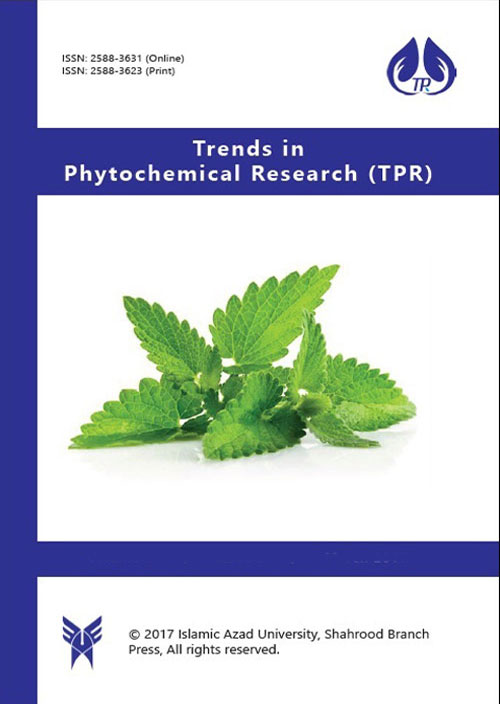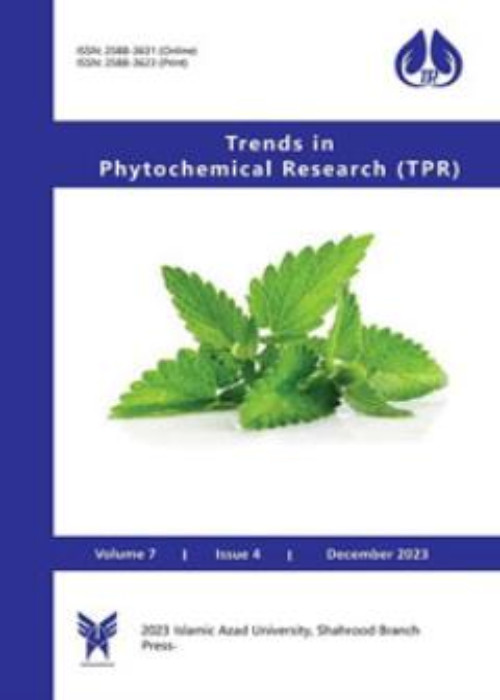فهرست مطالب

Trends in Phytochemical Research
Volume:4 Issue: 4, Autumn 2020
- تاریخ انتشار: 1399/08/19
- تعداد عناوین: 6
-
Pages 177-192
The objectives of this research were to investigate the qualitative and quantitative analysis of Ethyl Acetate Root Extract of Ardisia solanacea Roxb. (EREAS) and estimation of its biological activities. Phytochemical screening of EREAS showed the abundance of total phenolics, flavanoids, ortho-dihydric phenols, alkaloids, diterpenes and triterpenes etc. The quantitative analysis of EREAS was also carried out by GC/MS and α-amyrenone (13.3%) was found to be the major component. Antifeeding activity monitored through no choice leaf dip method against Spilosoma oblique. The results revealed dose and time dependent antifeeding activity, where the 100% mortality was observed signifying the intense insecticidal activity. The herbicidal activity of extracts was evaluated against the Raphanus raphanistrum seeds. Accordingly, EREAS showed effective herbicidal activity in terms of inhibition of seed germination, coleoptile length and the radical length. Evaluation of antioxidant activity was performed via DPPH radical scavenging, reducing power and metal chelating of Fe2+ activities. EREAS possessed potential antioxidant property and revealed good anti-inflammatory activity.
Keywords: α-amyrenone, antifeeding, Anti-inflammatory activity, Antioxidant, Ardisia solanacea, herbicidal, Insecticidal activity -
Pages 193-200The phytochemical study of the methanolic extract of the stem bark of Parkia bicolor A. Chev. (Leguminosae) led to the isolation and characterization of ellagic acid (1), 3,3’-dimethoxyel lagic acid (2), 3,3’,4,4’-tetramethoxyellagic acid (3), 3-glucopyranoside-3’-methoxyellagic acid (4), gallic acid (5), methylgallate (6), oleanolic acid (7), erythrodiol (8), β-amyrin (9), β-sitosterol (10), stigmasterol (11) and stigmasterol-3-O-β-D-glucopyranoside (12). The structures of these compounds were determined by spectroscopic analyses of 1D and 2D NMR and EI- and ESI-MS and comparison with the reported data. Compounds 1-4 are reported here from this species for the first time. The crude methanolic extract and isolated compounds 1-6 were submitted to micro dilution assay against the Gram negative bacteria Escherichia coli ATCC 8739 and Salmonella typhi clinical strain as well as the Gram positive bacterium Staphylococcus aureus clinical strain. While the methanolic extract showed moderate to significant antibacterial activ ity against above tests strain with MICs in the range of 64-128 μg/mL, compound 4 displayed the best activity against Salmonella typhi and Staphylococcus aureus clinical strains with an MIC of 33.4 μM against both, compared to gentamycin with 0.1-2.0 μM. Compounds 1-3 and 5, 6 showed moderate to weak antibacterial activity with MICs in the range of 44.6 ± 0.9 to 376.4 ± 1.5 μM. MBCs were above the MICs in the range of 128-512 μg/mL for the methanolic extract resulting in MBCs/MICs in the range of 2 to 8. In antifungal assays, the methanolic extract when tested at 50 mg/mL gave growth inhibition of 34.3, 31.3, 28.3, 33.1, 30.6 and 22.4 % against Aspergillus flavus strain 1, Aspergillus flavus strain 2, Aspergillus niger, Aspergillus gandidus, Ab sidia sp < /em>. and Penicillium sp < em>., respectively. When tested at 2 mg/mL, 4-glucopyranoside-4’-me thoxyellagic acid (4) showed a moderate inhibition potency against all the fungal strains with growth inhibition of 24.50 to 40.40% compared to fluconazole with 100% at 2 mg/mL.Keywords: Antimicrobial Activity, Ethnopharmacology, Leguminosae, Parkia bicolor A. Chev, Secondary metabolites
-
Pages 201-202About half a century ago, the separation science was blessed with the introduction of a new liquid-liquid separation technique called droplet counter current chromatography (DCCC) that combined principles of counter current distribution and counter current chromatography, and employed a liquid stationary phase held in a cluster of vertical glass columns connected in series. In fact, DCCC is based on the partitioning of solutes between a constant stream of droplets of mobile phase and a column of surrounding stationary phase.Keywords: Cornus florida, Droplet Counter Current Chromatography (DCCC), Hedera helix berries, High-speed counter-current chromatography (HSCCC)
-
Pages 203-212The chemical constituents, anti-inflammatory and anti-nociceptive activities of the leaf essential oil hydrodisitlled from the Gardenia jasminoides J. Ellis (Rubiaceae) were reported. The chemical constituents of the essential were analyzed using gas chromatography-flame ionization detector (GC-FID) and gas chromatography coupled with mass spectrometry (GC/MS). The hot plate and carrageenan-induced models were used to determine the anti-nociceptive and anti-inflammatory activities. The main compounds of the oil were pentadecanal 17 (49.2%), geranial 4 (12.3%), ar-turmerone 14 (8.2%) and 10-epi-γ-eudesmol 10 (6.2%). The essential oil of G. jasminoides at 100 and 400 mg.kg-1 doses significantly (p < 0.001) increased the latency period for the reaction duration in the anti-nociceptive study. The carrageenan-induced edema model reveals the suppression of inflammatory mediators (p < 0.001) within 1st, 2nd and 4th h for 100 mg.kg-1 dose, 1st and 4th h (200 mg.kg-1) and 1st-3rd h (400 mg.kg-1). The results indicate the potential of G. jasminoides essential oil as a source of pain relieving agent.Keywords: Anti-inflammatory activity, Anti-nociceptive activity, Essential oil, Gardenia jasminoides J. Ellis Terpenes
-
Pages 213-218Kaempferol 4´-O-α-rhamnopyranosyl-3-O-α-rhamnopyranosyl-(1→6)-β- glucopyranoside (1), a new flavonoid glycoside, along with eight known ones (2-9) were isolated from the flowers of Vicia faba L. (Leguminosae) which were identified as kaempferol 3-O-α-arabinopyranosyl-5-O-α-rhamnopyranoside (2), kaempferol 7-O-α-rhamnopyranoside (3), kaempferol 3-O-α-arabinopyranosyl- 7-O-α-rhamnopyranoside (4), kaempferol 3-O-rutinoside (5), kaempferol 3-O-α-rhamnopyranosyl-(1→3)-β-galactopyranosyl-7-O-α-rhamnopyranoside (6), kaempferol-3-O-β-galactopyranosyl-7-O-α-rhamnopyranoside (7), kaempferol-3-O-α-rhamnopyranosyl(1→6)-β-galactopyranosyl-7-O-α- rhamnopyranoside (8) in addition to a quercetin derivative; quercitin-3´-O-α- rhamnopyranosyl-4´-(3´´-acetyl)-β-galactopyranoside (9). Structure elucidation of the new compound was established based on 1D and 2D NMR analyses including 1H-, 13C-NMR, and HMBC experiments, in addition to HR-TOF-MS spectrometry using matrix assisted laser desorption ionization (MALDI).Keywords: 1D, and 2D NMR analyses, HPLC, New flavonoid glycoside, Vicia faba L
-
Pages 219-234
Genotype x environment interaction and stability were analyzed through Eberhart and Russell model among seventeen accessions/germplasms of turmeric (Curcuma longa L.) during three environments/years. For rhizome yield the mean performance over three environments showed that yield ranged from 241.41 q/ha (CIMCH14127) to 579.67 q/ha (CIMCH14229). Six genotypes namely CIMCH14107, CIMCH14171, CIMCH14165, CIMCH14130, CIMCH14208 and CIMCH14229 had significantly higher mean for rhizome yield as compared to the general mean. Among seventeen genotypes, five genotypes had more than 1 regression coefficient, while eight genotypes had less than 1 regression coefficient and four genotypes showed bi=1. For CIMCH14101, CIMCH14144, CIMCH14159, CIMCH14190, CIMCH14152, CIMCH14123 and CIMCH14164 S2di was significant. The stability parameters for rhizome yield revealed that CIMCH14171 and CIMCH14229 were stable for all environments. Three genotypes viz., CIMCH14107, CIMCH14130 and CIMCH14208 genotypes were suitable for unfavorable environments having mean values, bi
Keywords: Curcuma longa L, Genotype x environment interaction, Stability parameter, Turmeric, Variability


